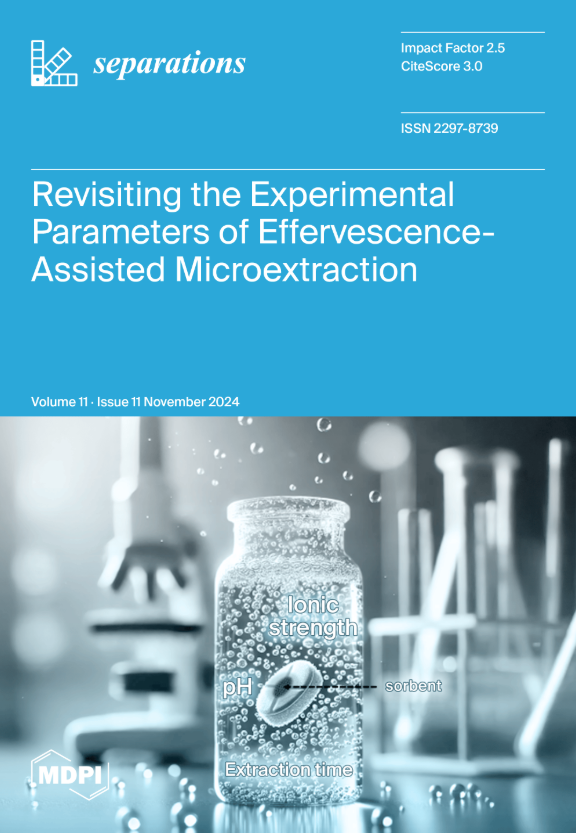使用混合型阴离子交换液相色谱法和亲水作用液相色谱法验证用于人体生物监测的尿液中草甘膦和氨甲基膦酸的液相色谱-质谱联用方法
IF 2.7
4区 工程技术
Q3 CHEMISTRY, ANALYTICAL
引用次数: 0
摘要
草甘膦类除草剂是世界上使用最广泛的杀虫剂;然而,草甘膦(GlyP)对人类的毒性,尤其是致癌性,还存在争议。这项工作的目的是验证尿液中草甘膦及其代谢物氨甲基膦酸(AMPA)的快速检测方法,用于人体生物监测。分析物在同位素标记的内标存在下通过固相萃取进行纯化。使用新型混合固定相色谱柱,结合阴离子交换和亲水相互作用液相色谱法,开发了一种 LC-MS/MS 检测方法。在混合式三重四极杆/线性离子阱质谱仪中使用负电喷雾离子化技术进行检测和定量。AMPA 和 GlyP 的保留时间分别为 1.44 分钟和 7.24 分钟。校准曲线显示线性动态范围最高可达 40 µg/L,运行间和运行内精确度小于 7.5%,准确度在理论浓度的 10% 以内。GlyP 和 AMPA 的定量限分别为 0.1 µg/L 和 0.5 µg/L。基质效应偏差通过内部标准进行了控制。成功参与外部质量保证工作增强了该方法的有效性。该检测方法被用于检测 9 位城市居民、26 位农村居民和 12 位农业工人尿液中的 GlyP 和 AMPA;虽然 AMPA 大多无法定量,但农村居民和工人尿液中 GlyP 的中位值分别为 0.1 和 0.34 µg/L。该检测方法可用于评估不同接触情况下人体尿液中的 GlyP 和 AMPA 含量。本文章由计算机程序翻译,如有差异,请以英文原文为准。
Validation of a Liquid Chromatography Coupled to Mass Spectrometry Method for Glyphosate and Aminomethylphosphonic Acid in Urine for Human Biomonitoring Using Combined Hybrid Anion-Exchange and Hydrophilic Interaction Liquid Chromatography
Glyphosate-based herbicides are the most widely used pesticides in the world; however, the toxicity of glyphosate (GlyP) toward humans, especially its carcinogenicity, is controversial. The aim of this work was to validate a rapid assay for measuring GlyP and its metabolite aminomethylphosphonic acid (AMPA) in urine for human biomonitoring. The analytes were purified via solid-phase extraction in the presence of isotopically labeled internal standards. An LC-MS/MS assay was developed using a column with a novel hybrid stationary phase combined with anion exchange and hydrophilic interaction liquid chromatography. Detection and quantification were performed using negative electrospray ionization in a hybrid triple quadrupole/linear ion trap mass spectrometer. The retention times for AMPA and GlyP were 1.44 and 7.24 min, respectively. Calibration curves showed a linear dynamic range of up to 40 µg/L, inter- and intra-run precisions <7.5%, and accuracies within 10% of the theoretical concentrations. The limits of quantification were 0.1 µg/L and 0.5 µg/L for GlyP and AMPA, respectively. The matrix effect bias was controlled using internal standards. Successful participation in external quality assurance exercises strengthens the validity of the method. The assay was applied to the measurement of GlyP and AMPA in the urine of 9 urban residents, 26 rural residents, and 12 agricultural workers; while AMPA was mostly not quantifiable, the median GlyP values were 0.1 and 0.34 µg/L in rural residents and workers, respectively. The assay is useful to assess GlyP and AMPA in human urine following different exposure scenarios.
求助全文
通过发布文献求助,成功后即可免费获取论文全文。
去求助
来源期刊

Separations
Chemistry-Analytical Chemistry
CiteScore
3.00
自引率
15.40%
发文量
342
审稿时长
12 weeks
期刊介绍:
Separations (formerly Chromatography, ISSN 2227-9075, CODEN: CHROBV) provides an advanced forum for separation and purification science and technology in all areas of chemical, biological and physical science. It publishes reviews, regular research papers and communications. Our aim is to encourage scientists to publish their experimental and theoretical results in as much detail as possible. There is no restriction on the length of the papers. The full experimental details must be provided so that the results can be reproduced. There are, in addition, unique features of this journal:
Manuscripts regarding research proposals and research ideas will be particularly welcomed.
Electronic files and software regarding the full details of the calculation and experimental procedure, if unable to be published in a normal way, can be deposited as supplementary material.
Manuscripts concerning summaries and surveys on research cooperation and projects (that are funded by national governments) to give information for a broad field of users.
The scope of the journal includes but is not limited to:
Theory and methodology (theory of separation methods, sample preparation, instrumental and column developments, new separation methodologies, etc.)
Equipment and techniques, novel hyphenated analytical solutions (significantly extended by their combination with spectroscopic methods and in particular, mass spectrometry)
Novel analysis approaches and applications to solve analytical challenges which utilize chromatographic separations as a key step in the overall solution
Computational modelling of separations for the purpose of fundamental understanding and/or chromatographic optimization
 求助内容:
求助内容: 应助结果提醒方式:
应助结果提醒方式:


